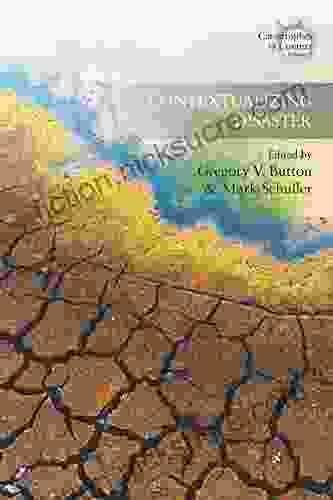Contextualizing Disaster Catastrophes: Unveiling the Complexities and Impacts

Disaster catastrophes, with their devastating consequences, have become increasingly prevalent and impactful in our world. To effectively mitigate their effects and devise comprehensive response mechanisms, it is imperative to move beyond isolated analysis and delve into the intricate contexts that surround these events. This article aims to contextualize disaster catastrophes, highlighting the complex interplay of factors that shape their impact and underscoring the necessity of a holistic understanding.
4.7 out of 5
| Language | : | English |
| File size | : | 1115 KB |
| Text-to-Speech | : | Enabled |
| Screen Reader | : | Supported |
| Enhanced typesetting | : | Enabled |
| Word Wise | : | Enabled |
| Print length | : | 356 pages |
Social and Economic Factors
Natural disasters, like hurricanes, earthquakes, or floods, have profound social and economic consequences. They disrupt communities, damage infrastructure, and cripple livelihoods. The extent of these impacts varies widely depending on socio-economic conditions. Developing countries with weaker infrastructure and limited resources often bear the brunt of these catastrophes.
In such contexts, poverty, inadequate housing, and limited access to healthcare exacerbate the effects of disasters. Slum dwellers and marginalized communities are disproportionately affected, lacking essential early warning systems, evacuation routes, and post-disaster support. Economic losses, including damage to property, disruption of businesses, and loss of employment, further compound the challenges faced by affected populations.
Environmental Factors
The environmental context strongly influences the severity and impact of disaster catastrophes. Climate change is a major contributing factor, intensifying natural disasters and making them more frequent. Rising sea levels, for instance, increase the risk of coastal flooding, while altered precipitation patterns contribute to droughts and wildfires.
Environmental degradation, such as deforestation and wetland destruction, also plays a role. These practices weaken natural buffers against disasters, such as forests that mitigate floods and wetlands that absorb excess water. Fragile ecosystems, like mountain regions and small islands, are particularly vulnerable to environmental changes and the cascading effects of disasters.
Psychological and Cultural Factors
Disaster catastrophes have profound psychological and cultural impacts. Survivors may experience trauma, anxiety, depression, and other mental health issues. The loss of loved ones, homes, and livelihoods can lead to long-lasting psychological scars. Cultural beliefs and practices also shape how communities perceive and respond to disasters.
In some cultures, disasters are seen as divine punishments or omens, influencing the coping mechanisms and resilience strategies adopted by survivors. Cultural norms and social support systems play a crucial role in determining how communities recover from disasters and rebuild their lives.
Historical Context
Historical experiences with disasters can significantly influence how communities prepare for and respond to future events. Past disasters leave behind institutional knowledge, shaping policies, building codes, and emergency response plans. However, historical biases and failures can also hinder effective disaster management.
For example, communities that have not experienced major disasters in recent history may underestimate their risk and fail to invest in adequate mitigation measures. Conversely, communities with a history of repeated disasters may become desensitized to risk, leading to complacency and a false sense of security.
Interconnectedness of Factors
It is crucial to recognize the interconnectedness of the social, economic, environmental, psychological, and cultural factors that shape disaster catastrophes. These factors interact in complex ways, amplifying or mitigating the impacts of disasters.
For instance, poverty can increase vulnerability to environmental hazards, while environmental degradation can exacerbate economic losses. Psychological trauma can hinder recovery efforts, while cultural beliefs can influence how communities adapt to disaster-induced changes.
Implications for Mitigation and Response
A comprehensive understanding of the contextual factors that surround disaster catastrophes is essential for devising effective mitigation and response strategies. Mitigation measures must not only focus on reducing physical vulnerabilities but also address underlying social, economic, and environmental inequalities. Early warning systems, evacuation plans, and disaster preparedness education should be tailored to specific socio-cultural contexts.
Response mechanisms should prioritize the needs of vulnerable populations, ensuring equitable access to relief, shelter, and healthcare services. Mental health support and trauma counseling must be integrated into disaster response plans to address the lasting psychological impacts of catastrophes.
Contextualizing disaster catastrophes is paramount for gaining a deeper understanding of their complexities and impacts. By considering the social, economic, environmental, psychological, and cultural factors that shape these events, we can devise more effective mitigation and response strategies. A holistic approach that integrates both disaster risk reduction and post-disaster recovery efforts is essential to building resilient communities and reducing the devastating consequences of disaster catastrophes.
4.7 out of 5
| Language | : | English |
| File size | : | 1115 KB |
| Text-to-Speech | : | Enabled |
| Screen Reader | : | Supported |
| Enhanced typesetting | : | Enabled |
| Word Wise | : | Enabled |
| Print length | : | 356 pages |
Do you want to contribute by writing guest posts on this blog?
Please contact us and send us a resume of previous articles that you have written.
 Fiction
Fiction Non Fiction
Non Fiction Romance
Romance Mystery
Mystery Thriller
Thriller SciFi
SciFi Fantasy
Fantasy Horror
Horror Biography
Biography Selfhelp
Selfhelp Business
Business History
History Classics
Classics Poetry
Poetry Childrens
Childrens Young Adult
Young Adult Educational
Educational Cooking
Cooking Travel
Travel Lifestyle
Lifestyle Spirituality
Spirituality Health
Health Fitness
Fitness Technology
Technology Science
Science Arts
Arts Crafts
Crafts DIY
DIY Gardening
Gardening Petcare
Petcare Melanie Marquis
Melanie Marquis Sterling Test Prep
Sterling Test Prep Chris Sajnog
Chris Sajnog Ben Stoeger
Ben Stoeger Dennis L Thombs
Dennis L Thombs Eileen Bailey
Eileen Bailey Lynn Clark
Lynn Clark Monica Gribben
Monica Gribben Beverly Bell
Beverly Bell Sydney Brake
Sydney Brake Ron Kaplan
Ron Kaplan John D Kelleher
John D Kelleher John Sabino
John Sabino Nadine Hays Pisani
Nadine Hays Pisani Christine M Benton
Christine M Benton Dk
Dk Kathleen Bartholomew
Kathleen Bartholomew Edward Dolnick
Edward Dolnick Stephen Harrigan
Stephen Harrigan Susan Campbell Bartoletti
Susan Campbell Bartoletti Molly Potter
Molly Potter Peter Mcdougall
Peter Mcdougall Ron Thomson
Ron Thomson Freddie Fernandez
Freddie Fernandez Julietta Suzuki
Julietta Suzuki Doug Cook
Doug Cook Jason Padgett
Jason Padgett Jane Nelsen
Jane Nelsen Starr Casas
Starr Casas Jacqueline Melvin
Jacqueline Melvin Rohan Agarwal
Rohan Agarwal Patti Feuereisen
Patti Feuereisen Dante Fortson
Dante Fortson Michael Conway
Michael Conway Joshua Bloom
Joshua Bloom Robert L Park
Robert L Park Michael Pewtherer
Michael Pewtherer Gordon Taylor
Gordon Taylor Victor J Strecher
Victor J Strecher Kathy Malloch
Kathy Malloch Laura Pavlov
Laura Pavlov Tom Cunliffe
Tom Cunliffe Mike Kephart
Mike Kephart William Martin
William Martin Olszewski Marie Erin
Olszewski Marie Erin Turk Pipkin
Turk Pipkin Mike Schultz
Mike Schultz Scott Bestul
Scott Bestul James E Wisher
James E Wisher Theodore Brun
Theodore Brun Britt Hawthorne
Britt Hawthorne Petr Beckmann
Petr Beckmann Jack Lagan
Jack Lagan John Balzar
John Balzar Steven Pustay
Steven Pustay Lawrence Goldstone
Lawrence Goldstone Mike Matheny
Mike Matheny Catherine Legrand
Catherine Legrand Barbara Ehrenreich
Barbara Ehrenreich Dr Ron M Horner
Dr Ron M Horner Ruby Hamad
Ruby Hamad Guy Fieri
Guy Fieri Jess Mahler
Jess Mahler Holland C Kirbo
Holland C Kirbo Martise Moore
Martise Moore Jillian M Parsons
Jillian M Parsons George E Tinker
George E Tinker Pam Coburn
Pam Coburn Grant Cunningham
Grant Cunningham Veronica Roth
Veronica Roth Bryan Litz
Bryan Litz Print Replica Kindle Edition
Print Replica Kindle Edition John H Falk
John H Falk Carolyn Highland
Carolyn Highland Kelley Armstrong
Kelley Armstrong Caitlyn Dare
Caitlyn Dare Elizabeth Baquedano
Elizabeth Baquedano N L Mclaughlin
N L Mclaughlin Harry K Mcevoy
Harry K Mcevoy Doug Howlett
Doug Howlett Veronica Chambers
Veronica Chambers Izaak Walton
Izaak Walton Massad Ayoob
Massad Ayoob Carolyn P Henly
Carolyn P Henly Linda Whitenton
Linda Whitenton Alan Agresti
Alan Agresti Randall Bell
Randall Bell Polo Tate
Polo Tate David M Killoran
David M Killoran 1st Edition Kindle Edition
1st Edition Kindle Edition Marcia Scheiner
Marcia Scheiner Randall Hicks
Randall Hicks Karl Fulves
Karl Fulves Michelle Maccarthy
Michelle Maccarthy Ben Greenfield
Ben Greenfield Vicky Cooper
Vicky Cooper Sean Turriff
Sean Turriff Malinda Lo
Malinda Lo Garth Nix
Garth Nix David Farrier
David Farrier Chris Fitch
Chris Fitch Gillian Bradshaw
Gillian Bradshaw Shankar Vedantam
Shankar Vedantam Stanislav Grof
Stanislav Grof Jon Haws
Jon Haws Lidia Stanton
Lidia Stanton Jane Mersky Leder
Jane Mersky Leder Chris Batha
Chris Batha J M Hofer
J M Hofer Kindle Edition
Kindle Edition Stephen Singular
Stephen Singular Jim Al Khalili
Jim Al Khalili Daniel S Milo
Daniel S Milo David D Burns
David D Burns Jenny Han
Jenny Han Arin Murphy Hiscock
Arin Murphy Hiscock Russell King
Russell King Isabella Emma
Isabella Emma Stan Utley
Stan Utley Ascencia Pharmacy Technician Exam Prep Team
Ascencia Pharmacy Technician Exam Prep Team Mark Chang
Mark Chang Carlo Zen
Carlo Zen Sylvia Hood Washington
Sylvia Hood Washington Michael Bamberger
Michael Bamberger Meg Haston
Meg Haston Michael Deangeli
Michael Deangeli Kaylene Yoder
Kaylene Yoder Hillary Davis
Hillary Davis Ivar Dedekam
Ivar Dedekam Sarah Krasnostein
Sarah Krasnostein Richard Louv
Richard Louv Tim Macwelch
Tim Macwelch Jacob Copeman
Jacob Copeman Elizabeth Harmon
Elizabeth Harmon Rachel Mitchell
Rachel Mitchell Patricia A Jennings
Patricia A Jennings Mike Stallard
Mike Stallard Clive Webb
Clive Webb Larry Dean Olsen
Larry Dean Olsen Jason Scotts
Jason Scotts M Helbig
M Helbig James Felton
James Felton Steve Barrett
Steve Barrett Julia Scheeres
Julia Scheeres The Mindset Warrior
The Mindset Warrior Malachi Martin
Malachi Martin Michael Geers
Michael Geers J T Williams
J T Williams Leon Pantenburg
Leon Pantenburg Orly Katz
Orly Katz Randy Vance
Randy Vance Taiwo Oduwoga
Taiwo Oduwoga Mary O Kane
Mary O Kane Kathryn Allen Rabuzzi
Kathryn Allen Rabuzzi Ross Campbell
Ross Campbell Larry Larsen
Larry Larsen Heather Smith Thomas
Heather Smith Thomas Pam England
Pam England Mindy Cockeram
Mindy Cockeram Tom Mchale
Tom Mchale Betsy Childs Howard
Betsy Childs Howard Martin W Ball
Martin W Ball Laura Michaud
Laura Michaud Linda Lajterman
Linda Lajterman Greg Vaughn
Greg Vaughn Glenn Whitman
Glenn Whitman David Kaiser
David Kaiser Ian Ball
Ian Ball Misty Griffin
Misty Griffin Angie Green
Angie Green Lilith Starr
Lilith Starr Anna Rashbrook
Anna Rashbrook Suellen Ocean
Suellen Ocean Michael Edelson
Michael Edelson Richard Barrett
Richard Barrett Lauren Drain
Lauren Drain Karla Marie Williams
Karla Marie Williams Neil Peart
Neil Peart Nawuth Keat
Nawuth Keat Michael Plymel
Michael Plymel Eric Butterworth
Eric Butterworth Sherry Simpson
Sherry Simpson Joseph Lumpkin
Joseph Lumpkin John Rousmaniere
John Rousmaniere Janet Godwin
Janet Godwin Nathan Fox
Nathan Fox Louis Berney
Louis Berney Kimberly Nix Berens Phd
Kimberly Nix Berens Phd Mary Blewitt
Mary Blewitt Jamie Della
Jamie Della Jillian Dodd
Jillian Dodd Alfred S Posamentier
Alfred S Posamentier Dave Bergman
Dave Bergman Toyo Kobayashi
Toyo Kobayashi Grantly Dick Read
Grantly Dick Read Robb Manning
Robb Manning Robert A Sadowski
Robert A Sadowski Patrick Sweeney
Patrick Sweeney Stephanie Greer
Stephanie Greer Craig Chappelow
Craig Chappelow Jack Harris
Jack Harris Emma Vanstone
Emma Vanstone Haruki Murakami
Haruki Murakami Ryan Burden
Ryan Burden Roald Amundsen
Roald Amundsen Peter Fretwell
Peter Fretwell Zainab Yate
Zainab Yate Peterson S
Peterson S Karl Polanyi
Karl Polanyi Nina Manning
Nina Manning Mike Carter
Mike Carter M J Fievre
M J Fievre United States Air Force
United States Air Force Patty Hahne
Patty Hahne Christine Lion
Christine Lion Gil Reavill
Gil Reavill Sam Fury
Sam Fury Richard Carlson
Richard Carlson Donald Fenna
Donald Fenna Dorothee Haering
Dorothee Haering Bob Palmer
Bob Palmer David Levithan
David Levithan Mitch Benjamin
Mitch Benjamin Diane Ackerman
Diane Ackerman Stephanie Wood
Stephanie Wood Peter Gandy
Peter Gandy Eileen Edna Power
Eileen Edna Power Kamran Nazeer
Kamran Nazeer Drew Smith
Drew Smith Business Mind
Business Mind David E Kaplan
David E Kaplan Paul Bellow
Paul Bellow Lloyd Freeberg
Lloyd Freeberg Jed Jurchenko
Jed Jurchenko Julie Sondra Decker
Julie Sondra Decker Sir Isaac Newton
Sir Isaac Newton Stef Maruch
Stef Maruch Benny Lewis
Benny Lewis Keith H Basso
Keith H Basso Janet Sasson Edgette
Janet Sasson Edgette Kay Burningham
Kay Burningham Ken Johnson
Ken Johnson Jan Lantier
Jan Lantier Kate Middleton
Kate Middleton Paul Barrett
Paul Barrett John Gray
John Gray Richard A Mann
Richard A Mann Alison Noice
Alison Noice Mercedes Lackey
Mercedes Lackey Og Mandino
Og Mandino David Olusoga
David Olusoga Ziya Tong
Ziya Tong John Allyn
John Allyn Rick Smith
Rick Smith John Steinbreder
John Steinbreder Vincent Chidindu Asogwa
Vincent Chidindu Asogwa Talise Xavier
Talise Xavier Jane Sanders
Jane Sanders Yves Pochet
Yves Pochet Anthony J Bennett
Anthony J Bennett Gerald Hirigoyen
Gerald Hirigoyen Charles Rubin
Charles Rubin Mark Mazower
Mark Mazower Julia Albu
Julia Albu Delaney Ruston
Delaney Ruston The Princeton Review
The Princeton Review Jonathan Gelber M D M S
Jonathan Gelber M D M S Scott Davis Howard
Scott Davis Howard Pass Your Class
Pass Your Class Carl Zimmer
Carl Zimmer Teresa Marrone
Teresa Marrone Peter Vermeulen
Peter Vermeulen Rob Reaser
Rob Reaser Michael Martin
Michael Martin Steve Sleight
Steve Sleight F Brent Neal
F Brent Neal Kennedy Achille
Kennedy Achille Dan Branagan
Dan Branagan P J Hatton
P J Hatton Mark J Hainds
Mark J Hainds
Light bulbAdvertise smarter! Our strategic ad space ensures maximum exposure. Reserve your spot today!

 Jeremy MitchellUnveiling the Treasures of Black History: The Ultimate Trivia Extravaganza
Jeremy MitchellUnveiling the Treasures of Black History: The Ultimate Trivia Extravaganza Eddie BellFollow ·2k
Eddie BellFollow ·2k Darren NelsonFollow ·15.1k
Darren NelsonFollow ·15.1k Quincy WardFollow ·11k
Quincy WardFollow ·11k Sammy PowellFollow ·15.7k
Sammy PowellFollow ·15.7k Earl WilliamsFollow ·7.7k
Earl WilliamsFollow ·7.7k Dwight BellFollow ·19.6k
Dwight BellFollow ·19.6k Marcel ProustFollow ·6.5k
Marcel ProustFollow ·6.5k Jaden CoxFollow ·7.5k
Jaden CoxFollow ·7.5k

 Charles Bukowski
Charles BukowskiDead Serious: Breaking the Cycle of Teen Suicide
Teen suicide is a...

 Rick Nelson
Rick NelsonSurviving My Years in the Westboro Baptist Church: A...
In the quaint town...

 Edwin Blair
Edwin BlairBuild Your Own Semi Auto Handgun: A Comprehensive Guide...
: Empowering Aspiring...

 Steve Carter
Steve CarterThe Laughing Jesus: Unmasking Religious Lies and...
The Prevailing Paradigm of Christian...

 Brett Simmons
Brett SimmonsComprehensive Fully Illustrated Reference for Modern...
Welcome to the...

 Steven Hayes
Steven HayesFraud, Negligence, and Greed: A Scathing Exposé of the...
**** In the annals of medical malfeasance,...
4.7 out of 5
| Language | : | English |
| File size | : | 1115 KB |
| Text-to-Speech | : | Enabled |
| Screen Reader | : | Supported |
| Enhanced typesetting | : | Enabled |
| Word Wise | : | Enabled |
| Print length | : | 356 pages |









